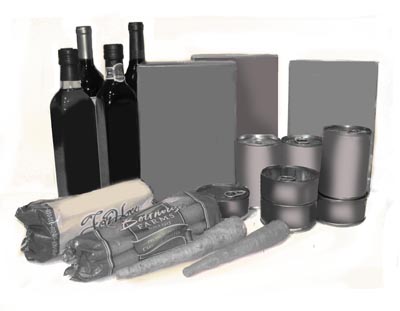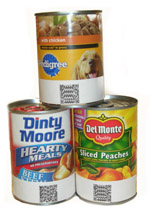Digit-Eyes is an audio labeling system that also reads
standard manufacturer' barcodes and announces the name of the
item. It also enables people to make and record their own
labels.
Davey is a Digit-eyes user. He has loaded the application on to
his cell phone, and he has printed several sheets of Digit-Eyes
barcode labels, which he keeps on the shelf with the cookbooks.
Davey goes to the supermarket. He comes home with one large
shopping bag and one large backpack full of groceries. There is
much to put away. He identifies the salad greens, tomatoes,
coffee beans, and sardines by touch, so he puts those items
away.
Davey has also bought some items that are harder to tell
apart. He has three cans of dog food, two cans of clams, a
can of beef stew and a can of peaches--all of which are similar
in size. he bought a box of dog biscuits, a box of breakfast
cereal and a box of "Nilla Wafers". Finally, he
has one bottle of nice red wine, one of vin ordinaire in similar
bottles plus one bottle each of vinegar and olive oil which are
unfortunately very much alike.
How to know what is what?

- Davey brings up Digit-Eyes on his phone, grabs one of the
bottles, and scans it until Digit-Eyes tells him it has
found the UPC.
- Digit-Eyes looks the UPC code up in the online database
and announces that the bottle Davey is holding is
"Stag's Leap Cabernet, 2006."
- Davey peels off one of his preprinted labels and sticks it
on the bottle.
- Davey scans his own label with Digit-Eyes.
- Digit-Eyes reads the barcode on Davey's label, and checks
to see if there is already a message recorded it. If there
is, the message would play, but since there is no other
recording for this code, Digit-Eyes says, "Tap twice to
record."
- Davey records his label: "Stag's Leap Cabernet, 2006.
Save this bottle for the wedding anniversary."
- Digit-Eyes stores Davey's recording on the cell phone.
- Davey puts the bottle away in the wine cellar behind a few
vintages neither he nor his wife like very much.
- Davey proceeds to the next grocery item and repeats the
steps above to scan the UPC code, identify the product, and
make his own audio label. Soonl all his groceries have
been labeled and put away.
Two hours later, it is time for dinner. Davey thinks he and
his wife would enjoy a nice salad, some beef stew, and a few  cookies for dessert. He
starts by going to the pantry. The canned goods there block out
the reception on his cell phone, so it's a good thing he does
not need to go online to read his labels. He takes a can down,
locates his own Digit-Eyes label with his finger, brings up
Digit-Eyes, and scans his label. The phone detects the code,
searches Davey's recordings to find the one that is associated
with it, and announces, "Del Monte peaches." Davey
tries the next can, "Dog food," and the next,
"Beef stew." Voila! Using the same method, Davey finds
the Nilla wafers. cookies for dessert. He
starts by going to the pantry. The canned goods there block out
the reception on his cell phone, so it's a good thing he does
not need to go online to read his labels. He takes a can down,
locates his own Digit-Eyes label with his finger, brings up
Digit-Eyes, and scans his label. The phone detects the code,
searches Davey's recordings to find the one that is associated
with it, and announces, "Del Monte peaches." Davey
tries the next can, "Dog food," and the next,
"Beef stew." Voila! Using the same method, Davey finds
the Nilla wafers.
Davey proceeds to his wine cellar. Surrounded by wine bottles
whose necks are wrapped in lead foil, he, again, discovers that
reception is very poor, but that's not a problem because
Digit-Eyes plays Davey's recordings without an Internet
connection. He scans his labels on the bottles, avoids taking
the special anniversary wine, and finds the everyday wine he
wants.
Davey goes to the fridge, grabs the lettuce and tomatoes and,
using Digit-Eyes, he is able to select the oil and vinegar.
He now has what he needs to make a light, but tasty dinner. He
tosses a quick salad. He uncorks the wine, opens the can, puts
the stew into a cooking container, stirs in a bit of the plonk,
and sets it to warm. While that cooks, he scans the Digit-Eyes
label on the can one last time, taps to delete the recording
from the phone, and drops the can into the recycling.
The meal is ready, and Digit-Eyes has done its job.
|